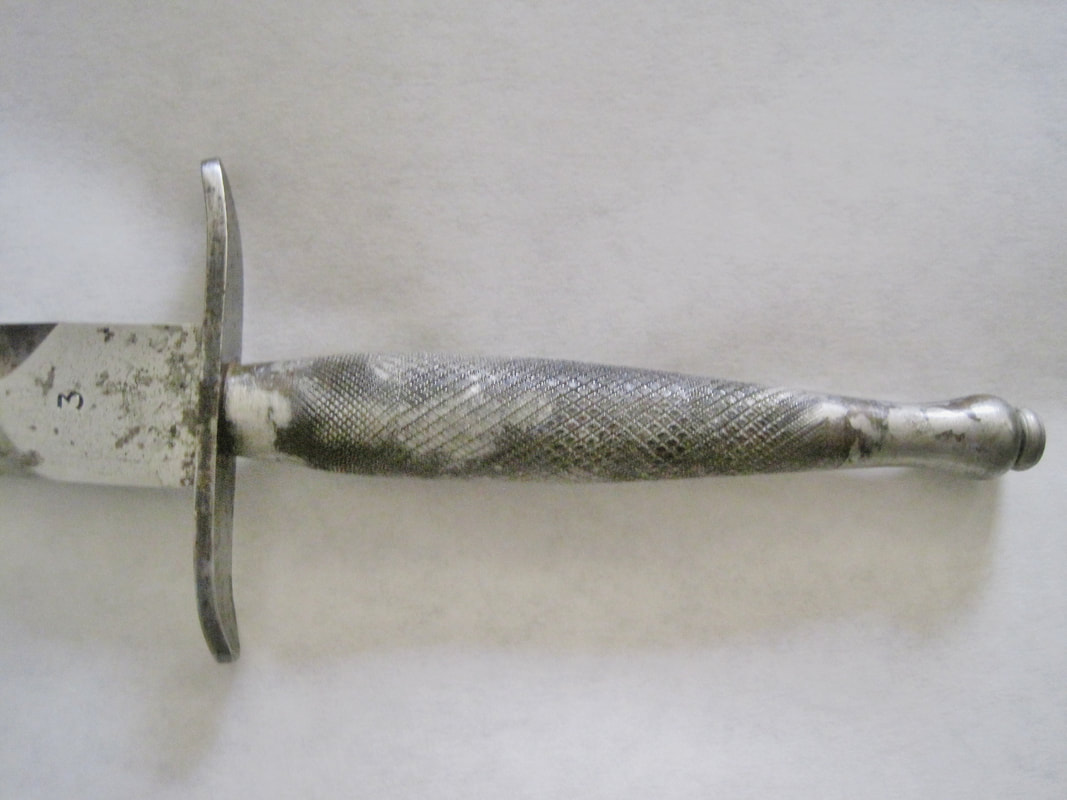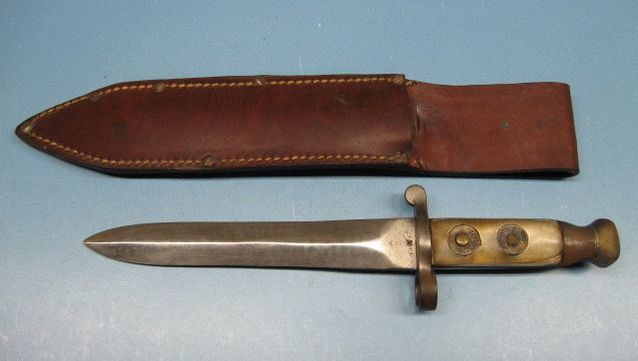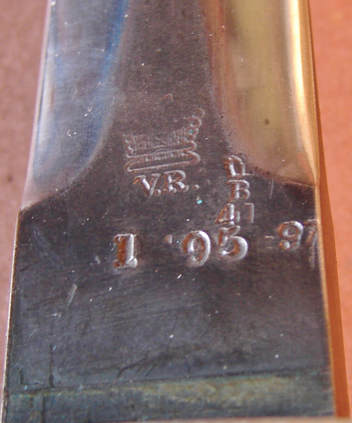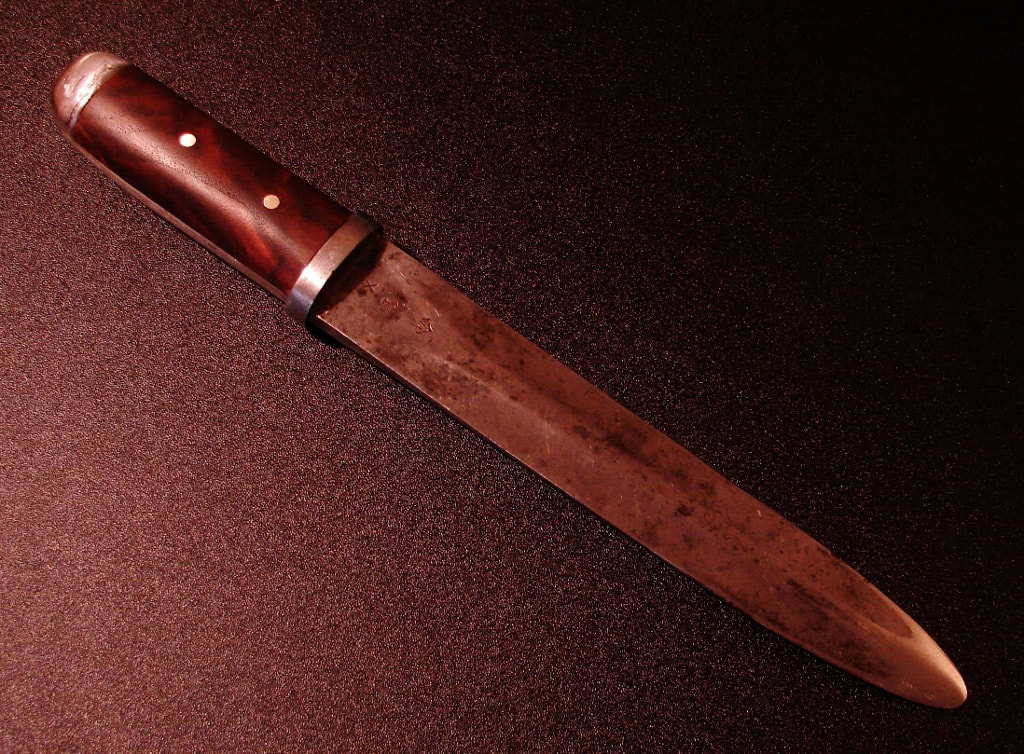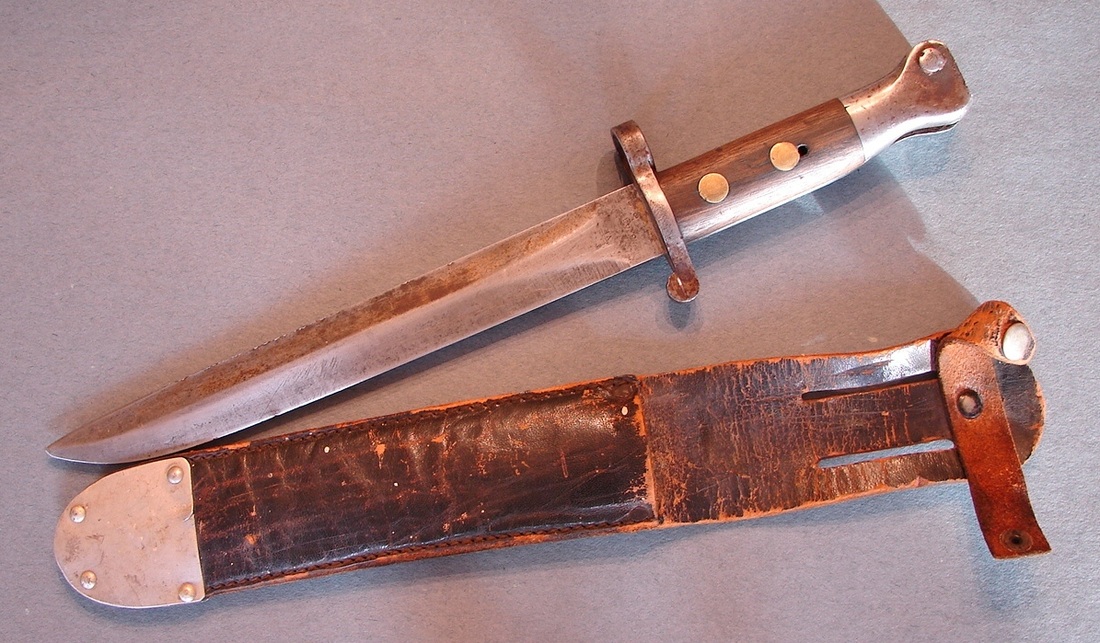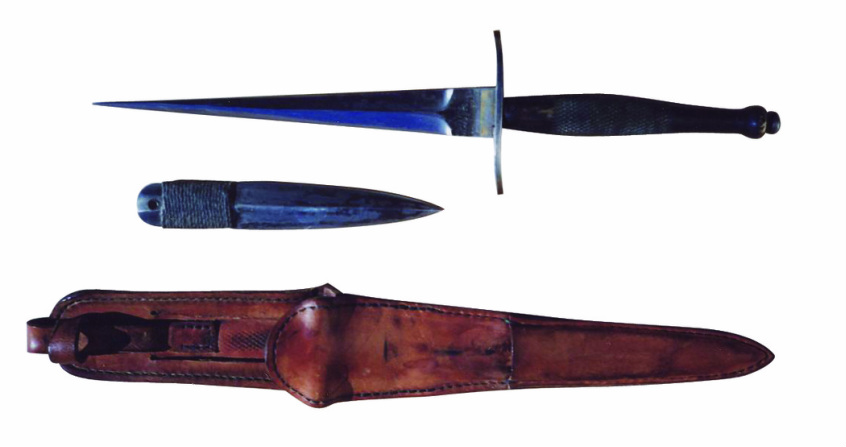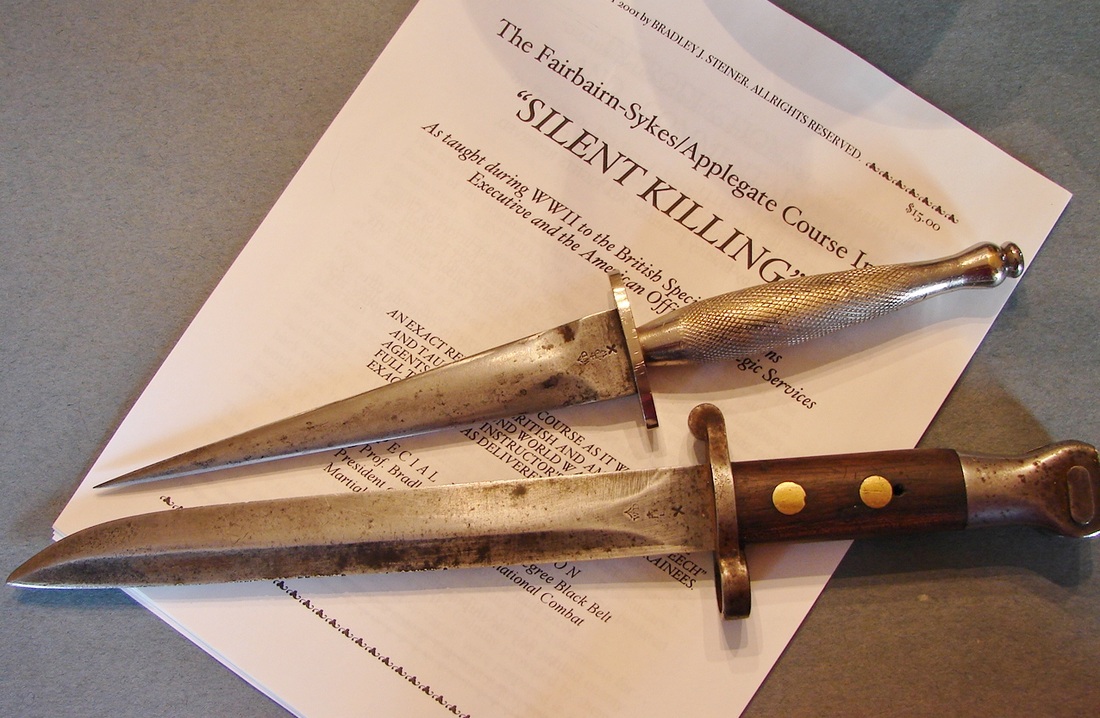X-Daggers - A Beginning:
This Page is Dedicated to the study of Lee-Metford F-S Style Knives:
Note many of the Following knives are the property of other collectors who desire to share them with myself and you. Quite often the collectors prefer to remain anonymous and we respect their wishes. The newest photos are inserted from the top down, starting below the bayonet photo. I leave that one near the top so you can see what the rest of the knives evolved from.
It is ironic that all of the writers who choose to declare X-Daggers are fakes, illegitimate, counterfeits, etc have to steal my photos to use in their papers and books. Why is that? It is because they do not own any of the knives and most of them have never handled the knives personally. How much confidence does that instill in you about their assumptions and conclusions? They refuse to admit this because it might damage their internet reputation as "experts." My book will prove their theories about X-Daggers are wrong.
Photos were stolen from this page (or the internet) without my permission for use in Olof Janson's new book on F-S knives. It's a nice book, I wish he would have asked permission and not labeled them as fakes. Olof has never examined any of my knives. In case you wondered why I am so short tempered with some of the members of other forums, this is why. It takes a certain level of chutzpah to steal someone's photo of their knife, publish it under the title of fakes, and then place their copyright marker over top of it! Then like jerks they act like the injured party when confronted about it.
|
Photo on the right is from Olof's book. It bears a striking resemblance to my photo above, don't you think? This knife is not factory converted nor is it from Canada. It might be from a backyard workshop, it might be a "one-off" theater-knife. What it is not, is a fake. It is a genuine WW-II knife owned by a British Veteran who served in WW-II.
|
Below: Here is a photo of the graceful Lee-Metford model 1888 Bayonet that has provided the source material for many knives, including Shanghai Daggers, X-daggers, my Paisley knives and much controversy among experts. This photo was graciously provided by a blade dealer Imp.Bayo on Ebay.
Another hard to classify dagger. Steel hilted and broad bladed with a beefy steel "S" guard. Beautifully made but, due to the broad blade, lacking the balance of a First Pattern or many of the X-Daggers in my collection. The W.S.C. initials stamped into it are always a point of contention amongst many "experts". I have my own opinion on what they stand for, which I have written up in my manuscript if I ever get it printed. It might surprise many of you.
X-Dagger or not? This dagger is not made from a bayonet blade because there aren't any armoury stamps anywhere. The sheath is also unique, although I seem to have seen a similar one somewhere before. The blade is of a broader profile than normally associated with these daggers. It is clearly stamped on the ricasso with the maligned J.P initials. On the side of the iron "S" guard there is a tiny "C" stamping. A large crack is present in the wood grip due to shrinkage. Knives like this are simply impossible to validate without critical provenance.
Below Left: John Paisley (J.P) knife with rare additional side knife. Right: "WSC C" marked knife believed to be owned by a member of No4 Cdo.
Below: NOTE: I now own this knife. I had hoped to disassemble it to examine the tang construction but alas the hilt is soldered in place. The best laid plans of mice and men often go astray........
Half - Conversions
Below: Another nicely half-converted 1903 Metford bayonet. The rifle attachment hardware and the original guard are unaltered. The blade has been expertly ground to 6 1/2 inches. All of the markings are intact with additional ones on the pommel. The maker's name, Chapman, is double stamped. A replacement sheath was made from heavy leather for it following its conversion to a fighting knife, and both knife and sheath are in terrific condition.
Below: A nicely reground Lee-Metford bayonet. The grind lines are symmetrical and the edges are sharp. Slabs of plexiglas were used for the handles and attached with brass rivets using Three Pence coins as washers. There is a thin layer of tin under the scales. A new pommel was made and soldered in place of the cut off rifle attachment point. A lot of work went into this modification including a very high quality sheath.
Below: My family of X- Daggers made from bayonets has grown to where I could not fit them all in one image. They came to me from all over the world; from the USA, Canada, England, Belgium, and Australia. They range from 9 inch long blades to the two minis. Primarily they are brass gripped with the single wood handled one and a couple with aluminum handles. It is obvious that no two are identical although some have similarities. The second and third knives from the left in the top photo are the only ones not made from bayonets but from steel stock. They are still of the same genre so I include them in the grouping of these Metford-Fairbairns.
Disparaging comments have been made on other forums stating that if Metford-Fairbairns are legitimate why are there so many different models, sizes, and differences in details. This is well explained in my manuscript. I'd simply ask; if one man was responsible for making fakes and selling them as rare factory-made knives why would he not standardize them and not create so many different models? I'll just leave it at that for now.
Below: This is a second grouping of X-daggers. Two of them are suicide daggers with cavities to hold cyanide "L" (Lethal) pills. The one on the far left is engraved on the blade with the owners name. Fourth from the left is one of only two that were made from 1888 bayonets. The others used 1903 models. The other one is second from the right and both of them have insanely pointed blades. These rank among my most favorite WW-II daggers. The knife fourth from the left is a close copy of the sketch in Fairbairn's book "Get Tough."
Below: J.P Dagger of questionable lineage. I'm not sure about this unusual variation of a J.P dagger. Is it a Paisley? Are any of them Paisley's? Who knows, but it intrigued me enough that I bought it at my price. It has a very unusual sheath but I know I have seen this version before. The question is where? The nicely shaped wooden hilt has split from shrinkage, a common problem with using wood. The split runs about 60% of the hilt from each end toward the middle. This blade is NOT made from a bayonet. It is more like the blades often stamped WSC/C. precisely ground, it is as hard as nails. There is a large numeral "1" on one guard flat and a tiny "C" on one side of the guard. Just another oddity added to the collection.
Below: One of the most poignard-like blades I have ever seen. It is a wonderful dagger made from an 1888 Lee-Metford bayonet. It has very crisp stamps for "VR", "X", and an interesting back to back "RR" stamp which stands for removed from service. I don't know why it was retired since it was stamped as passing the bending test. Perhaps there were issues with the handle or mounting hardware. Whoever ground this blade was a genius at the grindstone. The hilt and guard are nickel plated. The sheath has an internal metal chape. My good friend from the west coast actually gave me this knife. Simply an incredible act of generosity. X-Daggers do not come any nicer than this one!
Below: Technically speaking this is not an X-dagger since i do not believe it was made from a bayonet. BUT it is of the same genre's and with its 9 inch blade fits here best. There is no question of who made it or for whom. The blade is marked Darlington Loco (Locomotive) Works, England. It was made for a man named Smith service number D139075. If you have any information on this man please contact me so we can give his story. The handle is a composition of aluminum and plexiglas. Interesting that it has a 3 inch wide crossguard like on many of the X-daggers. This knife is similar in proportions to the Harold Brown dagger. Here is a beautiful Darlington Locomotive and coal tender.
More Half-Conversions
Illustrated below are an assortment of the "less-evolved" fighting knives made from partially converting the 1888 and 1903 Lee-Metford bayonets. These conversions were often field modified although, some evidence points to some of them being converted by Armouries throughout the war to provide S.A.S. and S.B.S. troops with a rugged fighting knife. Other ones were converted by individual troopers looking for a cheap fighting knife.
Below: Here is a modern conversion of a 1901 Lee-Metford bayonet into a fighting knife. Someone else started the conversion and I bought it as is. The blade was already shortened and the guard and pommel modified as seen here. The handles were missing and the bent brass rivets were still in the tang. So i cleaned up the point of the blade and made grips out of a dense piece of walnut. The blade was a veteran of the Queen Victoria era and has all of the appropriate arsenal stampings. At the left is a photo of the conversion at top, and an original bayonet handle below.
Below: It borders on criminal neglect that a nation as powerful as Great Britain would send men off to fight a war with crudely reground 1903 bayonets. It was considered ungentlemanly to fight with knives and therefore they were not part of the military inventory. Somehow the British Army was unprepared with edged weapons for WW-I, and then destroyed many of them after that "War to end all wars." Come WW-II and they were again unready to fight and relegated to using WW-I Trench daggers, hunting knives, kitchen knives, and knives like this, a weapon so blunt it might not have even penetrated human flesh. Is it any wonder that men who had an opportunity would privately buy a Fairbairn-Sykes knife or a Metford-Fairbairn! Compare this to even the lowest grade German Trench Dagger which were far superior. Today Britain is again at war with the possession of edged weapons and the common MOD approved Fairbairn-Sykes is a poor representative of the WW-II knives.
Enfield manufacture 1903
Below: Here is a field modified 1903 Lee-Metford bayonet. These have often been used in the making of X-Daggers. The man I bought this knife from said he brought it back from South East Asia in 1965. The sheath is quite old, appears to have been with the knife for some time, even though the knife is far too long to slide all the way into it. Other versions have been seen with professionally shortened, double edge ground blades. I recently missed an opportunity to buy one that was on auction from South Africa.
Below: Here is a double edged dagger I bought that is ground down from an 1888 or 1903 British bayonet. As mentioned I have seen these on several auction and forum websites. This is rather well done knife but I am not sure if it was an armoury conversion or not. The ricasso has numerous stampings, two of which indicate it was returned for repair or refurbishment at two different dates. The sheath is a reproduction, a copy of one for a Camillus WW-II M-3 fighting knife.
Below: One of those impossible to make bayonet conversions. I am sure my friend who rails against these will be waiting to shoot off an email to me. This one has had the stub tang modified in some way to produce a full tang knife. Obviously the original bayonet guard has been retained. Someone produced a nice, rugged sheath to house it. The blade was ground to about an 8 inch length and in the grinding lost the broad center rib normally found on these blades. Whoever converted it did an excellent job, creating a fully functional fighting knife from an obsolete 1888 bayonet. The blade is dated '97 (1897) and has a crisp "X" stamp.
Below: Here we have a beautiful Metford-Fairbairn complete with its modified scabbard. This knife is somewhat different than the others we have found because it lacks the needle-tip, instead having a more rounded tip. This would have made it a more robust fighting knife and less prone to breakage. I thank my friend Michel Gassier for sharing the photos of his knife with us. This knife has what appears to be a standard second pattern handle and an over-sized guard. In some ways this knife does not fit the pattern of other X-Daggers. The owner tells us.........
Here’s an interesting example of a possible ‘theatre made’ of an FS-style dagger made with a Mk-1888 Lee-Metford blade. Very well made indeed! All the knife and blade should have been blackened. Possible used by some ‘L’ Detachment Operators (previous SAS unit in Middle-East, 1941-42), Mediterranean British Commando’s theatre. Original Metford scabbard fitted with a British WW2 canvas (marked on back-side with broad arrow and ‘1940' stamped)
Blade length 18 cm.
Overall length 31 cm.
Enjoy!
Best regards,
Michel
Blade length 18 cm.
Overall length 31 cm.
Enjoy!
Best regards,
Michel
Below: Our first X-dagger from the Land Down Under. It is a splendid example and the photos do not do it justice! After conversion, the Wilkinson made blade is still a full eight inches long. Quite often the four inches taken off the point was made into a thumb dagger.
Below: Here is a very unusual WW-II dagger made from a full length Lee-Metford Bayonet. It was made for, or by, a US Army Ranger as indicated by the black arrow on the sheath. This makes for a very intimidating "toothpick" style dagger with a 12 inch blade. The ricasso has all of the usual British Amory stampings. The handle is made from leather washers and some unusual orange plastic material with an aluminum butt cap. It really does not make a good fighting knife because the blade is too long and cumbersome and unsharpened.
More X-Daggers:
When I first built this website I did not own an original X-dagger. That all changed with an email from a couple in England wanting to sell a knife. Since then I have added several more to our collection. That knife is shown near the bottom of this page. Posting of my X-Daggers brought responses from many other collectors who have for years owned these knives and argued for their acceptance as legitimate WW-II knives. A growing body of information and examples continues to expand our knowledge of these knives. Therefore we created this new page dedicated solely to the exploration of these knives known variously as Camp X-Daggers, Metford-Fairbairns, or Prototypes: Please contact us if you own one or have any information on them or have one you wish to sell.
Here is an interesting set of knives that I bought at separate times. They are both made from a Bayonet, the same one I believe. The Suicide dagger (left) is made from a Sanderson Blade (as illustrated below). They are both stamped with "B 2" and "JH". Obviously the leather for the sheaths is also from the same hide, based on color and weight. Therefore I am going to conclude that they were originally made at the same time by the same company or person for one individual named J.H. The questions remain, who made them, and who is JH? I believe that J.H. is Johannes Happe from X Company 10 Cdo.
Below: Here is a Suicide Dagger made from a bayonet blade. This time the blade is from "Sanderson Sheffield," as clearly stamped on the ricasso. Shorter than the average X-dagger, the blade is only 6 3/4 inches long. I believe the blade has lost a 1/4 inch at some time. The handle is rather long for the blade size but it still balances fairly well. So far I have not been able to unscrew the handle to check out the cavity for the "L" pill. Someone tightened it quite tight and I do not want to damage it getting it apart. The joint is barely seen, about half way down the handle. There are no makers marks on this bayonet-knife conversion. Is it possible that Sanderson actually did the conversion? Other Sanderson bayonet blades were converted into fighting knives issued in Belgium. The blade of this dagger is stamped 1903.
This Suicide Dagger was more cooperative and unscrewed, illustrating how the compartment for the "L" pill is accessed. The daggers are all constructed the same way. I found it interesting that the young man in the video explains how you could put the pill in your mouth ahead of time. This actually makes the idea of the suicide dagger more viable than I had thought. It would still be a difficult decision whether to place such a higly lethal pill in your mouth.
ALL of the images displayed here are either my own or posted with full permission of the owners.
Below: Images of a Fairbairn style knife made from a bayonet. The evidence (note the above photo) seems fairly overwhelming that this was a rather common conversion, not an isolated occurrence. This fine dagger exhibits the same aesthetics and design as most although its blade is slenderer than some of the others I have seen. I drove to Canada to visit with the owner and held this knife in my hand. It is an exceptionally fine X-dagger. This one is rather petite compared to some of the others in our collection. The maker narrowed the ricasso to the point the "WI" in Wilkinson, and the "N" in London were ground away. Regardless, it is clearly made from a Lee-Metford 1888 Wilkinson bayonet blade. The sheath is stamped with the Canadian mark, a "C" encircling a broad arrow. A gentleman I contacted at www.worldbayonets.com said the sheath appears to be one for a P1907 cut-down and fitted with a 1915 frog. Thanks for your help Ralph, and you've got a very nice website.
Below: Wilkinson London 1888 bayonet: Note the plethora of bayonet stamps on the ricasso similar to my first X-Dagger from England. Note also the "VR" for "Victoria Regina" (Queen Victoria). This knife has a traditional two inch "S" guard similar to a Wilkinson First Pattern. The opposite side ricasso has the War Dept. stamps and "X" bending test mark.
Below: Here is a full length photograph of a "WSC" dagger. It has an additional "C" stamped into the ricasso. Some speculate this "C" was for Canada and others for Commando. This particular knife was purchased several years ago from the estate of Major Paul Dehn after he passed away. Dehn was one of the officers serving at Camp X (STS 103) during WW-II in Canada. We are very fortunate to now own this dagger and make it a part of our collection. It is fitted in a buttonhole style sheath notably used at Camp-X for inside the waistband carry. The sheath would be attached to a suspender button.
Major Dehn is second from the left in this photo. Photo credits Camp-X Photo Gallery. http://www.camp-x.com/ Please visit their interesting website and learn more about the history of this important facility that trained OSS and SOE operatives and provided secure communications between Washington, New York City, Canada, and Great Britain.
Below: I apologize for the fuzzy photo but it is a scan of an old photo that was not too sharp to begin with. There is something particularly interesting about the top two daggers, and maybe all three. Can you tell what it is (other than the one is wood handled)? Yes they are all made from bayonet blades. It is something more obscure than that. They are John Paisley suicide models with secret cavities in the handles to hold a cyanide capsule under the fake top nut (top and bottom knife) the middle knife has a screw-apart handle I believe.
Below: Largest of my X-Daggers and inscribed to Harold A. Brown. A formidable fighting knife! Alongside it is a standard Wilkinson 1st Pattern for comparison.
Harold Anthony Brown: Born in 1917, in or near Providence, Rhode Island. He was working in the textile trade when he enlisted in the U.S. Army National Guard in 1941 for a period of one year. (I'll bet he was surprised when the war went on for another four years!) He was inducted, became a Private First Class (PFC) and was assigned to a Field Artillery Battery. He mustered out as a Corporal and died in 2002, in Providence Rhode Island. Seems like so little to tell about a man who served his country but that is all I have for now. If you know more about this knife or Mr. Brown please contact us using the form on the references page. Our belated thanks to Harold A. Brown and all WW-II veterans for their service. Check out the "Stories" page for more examples of fighting knives and the veterans who carried them.
Below: Here is a fine collection of X-Daggers and First Pattern knives with three inch guards (one of which is a Wilkinson). These are the cream of the Fairbairn-Sykes genre'. Photos courtesy of one of our friends who wishes to remain anonymous.
Below: Photos of a nice Lee-Metford Fairbairn. As time passes more and more of these knives surface as people find their way to our website and share images of their collections with us. I am extremely grateful and appreciate the support our visitors have given. Many of them prefer to remain anonymous.
Below: Here is an exciting Fairbairn style knife made from a bayonet with a distinctively daggered blade and three inch wide guard. The grinding is very professional. The sheath has been fitted with a pocket for a large thumb dagger, made from the tip of a Lee-Metford bayonet blade.
Dr. Bill Windrum, who authored many articles and several books on military knives, was the first to publish the list of what he considered wartime
manufacturers code numbers. This list has also been the subject of controversy for several years. The man who put the list together served in clandestine operations in World War II. He was also a major collector of weaponry and eventually sold off a lot of his collection to purchase land in the new world. Some items from his collection have been on loan to several British Museums. Some of them are here in our collection. I remain neutral on this whole topic, not wishing to cast aspersions on any of the characters involved.
manufacturers code numbers. This list has also been the subject of controversy for several years. The man who put the list together served in clandestine operations in World War II. He was also a major collector of weaponry and eventually sold off a lot of his collection to purchase land in the new world. Some items from his collection have been on loan to several British Museums. Some of them are here in our collection. I remain neutral on this whole topic, not wishing to cast aspersions on any of the characters involved.
Below: I think in this photo you can appreciate the long, heavily daggered blades and broad ricasso. These attributes are more pronounced in these early knives than in the First Pattern knives. The general heft of the X-daggers is noticeably heavier than a First Pattern, but they remain well balanced as Fairbairn specified. To hold an X-dagger, and then a First Pattern, you would find the X-dagger a real delight. These knives were strictly intended for killing and not for any utility purposes.
Prototype-Home-Made? First among First Patterns?:
The following knife is our 2nd X-dagger. (I forgot the Paisley was my first) A husband and wife in England graciously sold me this knife. I am grateful for their friendship and straight-forward dealing with me. Like many of these knives, the provenance is not paper-documented but handed down verbally. For those of you for whom this is not credible “proof”, that’s OK, believe what you will. Proof will be forthcoming in my new book. I might add for the doubters among you, that documents or certificates of authenticity are more easily forged than a fighting knife.
The following knife is our 2nd X-dagger. (I forgot the Paisley was my first) A husband and wife in England graciously sold me this knife. I am grateful for their friendship and straight-forward dealing with me. Like many of these knives, the provenance is not paper-documented but handed down verbally. For those of you for whom this is not credible “proof”, that’s OK, believe what you will. Proof will be forthcoming in my new book. I might add for the doubters among you, that documents or certificates of authenticity are more easily forged than a fighting knife.
Below: Our Second X-Dagger? This interesting knife was found in a box of bits: military patches, moth eaten sergeants stripes, Commando cap badges, and a First Pattern Wilkinson knife. The blade of this X-Dagger is made from a Lee-Metford model 1888 bayonet. This knife has been fitted with a nickel plated first pattern style handle and top nut. The tang has been properly peened over to secure the nut in place. The blade's ricasso is stamped “Wilkinson London", among other thing, like "VR" (for Queen Victoria) and the usual proof marks. The sheath is confusing, it appears to be a second pattern style with a first pattern leather strap and Newey snap replacing the traditional elastic band. The cross guard is nickel plated brass. The grinding is not up to Wilkinson's standard, so I cannot say who re-ground and mounted it. The balance of this knife is exquisite.
Below: Some of the WW-II military badges that were found in the box with the two knives.
Shown in this photo is a fighting knife ground from a similar Lee-Metford style bayonet. For additional information please check the "Stories" section. The bottom knife in this photo is the one brought back from Southeast Asia by a soldier in 1965. (More images of it near the top of the page.)
Note the commonality of stampings between the two knives, the prototype and the Paisley. They are both stamped with the broad arrow, X for bending test, small crown, and WD for War Department. Also note the coarse knurling on the Paisley.
John Paisley Bottom Knife, English X-Dagger Top Knife: The mystery surrounding John Paisley, and all of the so-called X-Daggers seems unsolvable. As I mentioned before, one author has come to the conclusion that the man John Paisley is a fabrication, a persona made up for the purpose of deceiving knife collectors. This is not an opinion shared by all experts in the field of Fairbairn – Sykes fighting knives. Obviously I am not of that opinion or I would not have bought this knife or the X-dagger. I bought the Paisley dagger in 2010, fully aware of its clouded provenance. There were other buyers waiting with money in hand to buy it if I did not. The Paisley is the bottom knife with the blackened handle and longer blade. If these daggers are fakes, then no finer fakes are to be found. Another full length photo of the John Paisley dagger and its sheath is posted below.
Below: John Paisley Dagger: I am personally convinced of the legitimacy of this dagger, it being WW-II vintage, and the story I was given to be true. I do have some tantalizing information concerning these knives that will come to light later. Made by the elusive John Paisley, Glasgow, Scotland, note the similarity of this sheath to those issued with Australian Commando knives.
Below: A few more detailed photos of the J.P dagger. Want to know what is under all of the chisel marks on the guard? So do I. So far no one has offered an answer. Surely someone out there must be curious why someone would take a chisel to such a nice knife. Once someone figures it out I will post the answer here. So far no correct answers after all this time! We need a forensic Scientist.
|
On the Right: J.P
Do you know who this person is? He is a mystery man whose very existence has been called into question along with his works. His name is John Paisley and a pair of his knives are illustrated in the pages of Peter Mason's autobiography (see the page on Peter Mason). The sleeve dagger we have illustrated under Agent's Daggers is obviously attributed to John Paisley. The only John Paisley fitting the time frame and location (Glasgow) was a jeweler. He and knife maker Bruce Hand disappeared after the war. An internet search will return almost no information except a paper questioning Bruce Hand and John Paisley as fantasy and fabrications. The picture at the right was provided by the man whom I bought the J.P dagger from. The image shows John Paisley working at his forge in Scotland. The knife belonged to the seller's father's, who purchased it from William Windrum. Ironically, DR. Windrum for many years has been considered the authority on Fairbairn-Sykes and clandestine knives. That was before the new generation of "experts" came along. Today a few people seem bent on disproving almost everything Dr. Windrum wrote, based on what? "Proof" They have none. It ultimately becomes a matter of opinion. We are building a body of knowledge on X-daggers. And who do we glean our information from? A man who is very familiar with the knives, and Capt. Mason* . He also knows the current owner of some of the original Metford knives. We now have two other sources who have spoken with WW-II veterans who recounted their stories of being issued similar knives during the early years of the war, referring to them as "Metford-Fairbairns". A new source tells of buying thumb daggers from a retired Wilkinson employee. They were made many years ago from bayonet tips by that retired employee. These were scrap left from making bayonet knives. One source has informed us some of the people involved in the story are protected by a 100 year war secrecy act, not the usual 50 year one. One of our sources says that skeptics don't take into account a program created to help some people "disappear" after the war. He told me when these arguments arose about the "untraceable people" to simply tell them one word, "Increments." If you have any information to share with me about John Paisley, his knives, or his forge please contact us through the links page. Any information on Bruce Hand is also welcomed. |
John Paisley at His Forge, Glasgow, Scotland
Important Note: After four years of searching we are closing in on the actual location of the forge in the photo and will inform you once it is confirmed. This has been a multi-faceted story with a very convoluted trail. |
Below: Another beautiful Metford-Fairbairn with an interesting guard featuring down-swept ends and a thumb relief. Having practiced and taught the Art of Knife-fighting, of all the various guards I have seen this one would, in my opinion, be the most effective in a combat role. My views of W.E. Fairbairn and the presence of three-inch guards has changed considerably from my early days of skepticism to one more contemplative. Once I have sorted it all out I will add a post explaining those views. There are so many things that could be cleared up were the main characters still with us. Instead we are left to recreate as best we can their intentions and methods and extract from their writings, and oral history, as much knowledge as possible.








